
International Journal of Scientific & Engineering Research, The research paper published by IJSER journal is about System Design, Mathematical Modelling and Simulation of Process Drying in a Solar-Gas Convective Tunnel Dryer 1
ISSN 2229-5518
System Design, Mathematical Modelling and Simulation of Process Drying in a Solar-Gas Convective Tunnel Dryer
Hatem Oueslati, Salah Ben Mabrouk, Abdelkader Mami
Abstract— In this paper, we present a study of convective drying for wet agricultural product by hot air. The system used is a tunnel dryer, it works with different sources of energy (solar, gas, electric), and has been conceived to dry several agricultural products. This system operates in open loop for adjustable air in temperature and velocity. The objective of this work is to establish a mathematical model describing the phenomena of heat and mass transfer at the product layer and in the air. The drying process is simulated under real operating conditions based on a thin layer model and experimental drying kinetics.
Index Terms— Tunnel dryer, Mathematical model, Heat and mass transfer, Simulation.
1 INTRODUCTION
—————————— ——————————
He drying of a thin layer of granular products with low temperature is very important in the field of food industries. Some products with low humidity (wheat, corn ...) only need a drying with an ambient air. Other products with quite humidity, but less sensitive to degradation (hazelnuts, wood booklet ...) can be dried for long periods with little air ventilation. These processes are very energy efficient. Other food products with high humidity (grapes, dates, apples ...) occur in dryers increasingly sophisticated allowing a rational
conduct of the operation.
The drying air is constantly monitored by velocity,
temperature and humidity to ensure quick and effective
drying that does not alter the aesthetic and nutritious qualities of the product. They may be refined if one knows better the evolution of simultaneous heat and mass transfers in the product and at the air product interface.
Properly, designed solar drying systems must take into
account drying requirements of specific crops, energy efficiency requirements, and cost-effectiveness. Simulation methods are needed in the designs and operations of solar dryers. Several researchers have developed simulation models
————————————————
Hatem Oueslati: Laboratory of Analysis and Command Systems, Department of Electrical Engineering, National Engineering School of Tunis, Po. Box 37, Tunis El Manar 1002. Tunisia.
Phone: +216 96 23 14 94, e-mail: Houeslati@gmail.com .
Salah Ben Mabrouk: Laboratory for Energy and Thermal Processes, Centre
for Research and Technologies of Energy (CRTEn), Po. Box 95, Hammam- Life 2050. Tunisia.
Phone : +216 97 29 98 44, e-mail: Salah.Benmabrouk@crten.rnrt.tn .
Abdelkader Mami: Laboratory of Analysis and Command Systems, Department of Electrical Engineering, National Engineering School of Tunis, Po. Box 37, Tunis El Manar 1002. Tunisia.
Phone : +216 98 44 57 66, e-mail : Abdelkader.mami@fst.rnu.tn .
for natural and forced convection solar drying systems [1-3]. This study was mainly concerned with the description of drying mechanisms using an indirect convection solar dryer under ecological conditions typical of north eastern region of Tunisia [4]. Thus, the study of the tunnel dryer is to establish on the one hand, a relationship between the characteristics of the air entering and exiting the tunnel, on the other hand, an equation between the drying time and layer characteristics of the product.
Our study was based more on the knowledge the dryer than that of the dried product that’s why in this study we present a mathematical model that simulates the dynamic operation of the dryer and to extrapolate results under specific conditions.
2 MATERIALS AND METHODS
An indirect forced convection solar dryer consisting of a tunnel dryer and four solar air heaters was used in all drying experiments. The tunnel dryer is a compartment of 4 m x 2 m x
1.8 m, oriented to the South, and constituted by the drying
cabinet and the auxiliary heating system. The width of the cabinet passageway is 0.9 m. On the roof of the drying cabinet, a solar chimney has been predicted and has the role of pumping down the humid air. The tunnel dryer was constructed with galvanized iron sheet wall insulated with polyurethane injection of 0.15 m thickness (Fig. 1). The drying trays were made of an iron frame on all four sides with wire mesh on the bottom to hold the sample.
Fours solar collectors are placed next to the drying cabinet and an angle of inclination varying between 36.7° and 45°, in order to collect the maximum solar radiation according to the drying time. Ambient air was drawn in by a fan and heated up in the solar air heaters. The heated air was allowed to enter in the drying cabinet from the eastern side and flow upward through the sample and finally though the trays (Fig. 1).
IJSER © 2012
International Journal of Scientific & Engineering Research The research paper published by IJSER journal is about System Design, Mathematical Modelling and Simulation of Process Drying in a Solar-Gas Convective Tunnel Dryer 2
ISSN 2229-5518

Fig. 1. Overall view of the solar-gas tunnel dryer pilot.
We opted for natural gas as a fuel to be used on auxiliary heating system. This extra provider fitting is placed in the north of the drying cabinet. The separation between the two passageways has a good thermal conductivity, whereas the north side is perfectly insulated. An exchanger permits to transfer heat produced by the burner to the incoming air. The western side of the tunnel dryer carries in its centre two fans that blow the hot air in the drying cabinet.
The product slices are placed, in an adjacent way, on trays located on moving farm tracks or carriages. The height between every two trays is 10 cm. The thickness of the thin layer is that of one layer of slices. To measure material temperatures, thermocouples K and T were either introduced inside the product slices or put at their surface. The whole dryer is designed in order to assure the installation security (flame control, electric protection) and to manage drying parameters regulation.
3 THEORETICAL APPROACH
The system studied is a tunnel dryer with partially solar heating (Fig 1). The first feature of this dryer is its use of the solar energy. Indeed, it was realized over the years, the sun offers exciting potential that would be a loss not to exploit them. It is a renewable energy represents an available market, in addition to be practically free.
The work presented focuses on the analyzing and modeling of the phenomena of heat and mass transfer in the dryer during the drying operation of the moist agricultural product.
The figure 3 describes the process of drying a layer of product placed in a flow of hot air.
Several assumptions are made in order to obtain the macroscopic scale governing equations as:
Air density is constant.
Air velocity distribution in the dryer is uniform.
Air and water vapour are considered as perfect gases.
The shrinkage of the product during the drying is
neglected and the product can be estimated to a thin layer of water.
The phenomenon of water condensation on the inner metal walls of the drying chamber is neglected and so is the radiative transfer phenomenon inside and outside the drying chamber.
Hot air is provided by two sources, the solar module and the auxiliary heating unit for a combined operation or by the module solar for only solar drying (Fig. 2).
The room is supposed waterproof and soil losses are neglected.
The exchange surfaces air-product remain constant
during drying.
All the products are considered a homogeneous,
which are characterized by it’s superficial
temperature.
The studied system is considered with lumped
parameters, that has an evenly distributed temperature.
IJSER © 2012
International Journal of Scientific & Engineering Research The research paper published by IJSER journal is about System Design, Mathematical Modelling and Simulation of Process Drying in a Solar-Gas Convective Tunnel Dryer 3
ISSN 2229-5518

Output moist air
Ambiant air
Solar module
Auxiliary module
Drying air
Trays
Drying chamber
Fig. 2. Flow diagram of drying process in a tunnel dryer.

Fig. 3. Schematic description of drying process in a tray.
The various transfers retained are:
- Between the air and the product: convection and vaporization of water.
- Between the air and walls: heat exchange by convection.
- Between internal air and outside air through the walls
i) Product
The mass conservation of water in the agricultural product is written as:
[Change in the amount of water in the product] = - [Water
evaporated from the product]
(thermal loose): heat exchange by conduction.
m pr
![]()
dX
![]()
dt mv
(1)
![]()
Or ( i )
mv hm A pr
Pvs Pv
(2)
The mathematical model was developed based on the
hm (ms-1) is the mass transfer coefficient determined by
Colburn–Chilton analogy [5], and is expressed by:
energy balance equation on the various components of the
tunnel solar gas dryer.
hm
hc
![]()
a C pa
(Le)2 / 3
(3)
IJSER © 2012
International Journal of Scientific & Engineering Research The research paper published by IJSER journal is about System Design, Mathematical Modelling and Simulation of Process Drying in a Solar-Gas Convective Tunnel Dryer 4
ISSN 2229-5518
With hc (Wm-2C-1) the convective heat transfer coefficient,
Le( 1) the Lewis number of the air, a (kg/m3) the density and
Where
hc1
![]()
Nu a
D
(10)
C pa the specific heat of the air.
Pvs (Pa) is the saturated water vapour pressure at the surface
In which Nu is the Nusselt number established on the basis of Reynolds number (Re), that gives an idea about the flow
of the product and is given by the Bertrand relation:
regime,
a is the thermal conductivity of air and D is the
2795
![]()
log (Pvs ) 17.443 3.868 log (Tpr )
(4)
characteristic diameter of the layer of the product.
The Reynolds number is expressed as:
u L
10 Tpr 10
![]()
Re a
(11)
Where, the temperature is in Kelvin.
Pi (Pa) the partial vapour pressure of the moist air in the
v
chamber, it’s often given by this relation [6]:
Where:
L : Characteristic length (m)
u : Air velocity (m.s-1)
Pi P
(T ) (T
T )
(5)
v vs a ai a
Where 66Pa.K 1 is the psychometric constant.
: Kinematic viscosity of air (m2.s-1)
The airflow will certainly be turbulent in the dryer, to calculate
Apr
(m2) is the area of product.
the number of Nusselt we use the following correlation [8]:
ii) Moisture in the air
The balance of water masses in the air exchanged during the drying is written as:
Nu 0.023.Re0.8 .Pr0.4
Pr = 0.7 (air Prandtl number).
(12)
[Change in the amount of water in the air] = [water outside air entering] + [water evaporated from the product] - [water of the exhaust air]
The equation for the energy balance in the air is written as:
[Change in internal energy of the air inside the dryer] = [Enthalpy flow of the air entering into the dryer] - [Enthalpy flow of the air leaving the dryer] + [Enthalpy flow of the water![]()
m dY m Y
m m Y
(6)
evaporated from the product] - [heat exchanges by convection![]()
a dt
ai in v ao
between the air and the product] - [convective heat flow![]()
![]()
Where mao is the exiting air mass flow and is given by [7]:
between the air and the inner wall]
m C
a Ao
2gl(Ta Tam )
(7)
V C
![]()
dTa m C T
m C T
ao d
1 Ao / Ai
Tam
![]()
a a p,a dt ai pa ai ao pa a
(13)
Ai and Ao
are inlet and outlet area (m2) of the chimney![]()
mvC pvTa hc1 (Ta Tpr ) Apr hc 2 (Ta Twa ) Awa
openings which has a cylindrical form.
Cd , g and l are coefficient of discharge of air channel, the
Where Awa
is the area of the wall and
hc 2
is the convective
gravitational acceleration, (m.s -2) and the height (m) of solar chimney respectively.
heat transfer coefficient between the moist air and the inner wall, taking as Nusselt number [8]:
Nu 0.036.Re4 / 5 .Pr1/ 3
(14)
The equation for the energy balance in the product is written as:
[Change in internal energy of the product] = [energy of evaporation of water from the product] + [heat exchanges by convection between the air and the product]
The energy balance equation of the wall of the drying
chamber is written as:
[Change in internal energy of the inner wall] = [convective heat flow between the air and the inner wall]-[conduction heat flow between internal air and outside air through the walls]![]()
dT pr
V C
dTwa h
(T T ) A
m prC p , pr
![]()
mv Lv A pr hc1 (Ta T pr )
dt
(8)![]()
wa wa p,wa dt
c3 a wa wa
(15)
Where Lv
is the latent heat of vaporization:
hd (Twa Tam ) Awa
Lv Lv 0 (C pv C pl )T pr
(9)
Where
hd (W/m2°C) is the conductive heat-transfer coefficient
Lv 0 is the latent heat of vaporization at 0°C.
hc1 is the convective heat transfer coefficient between the hot air and the agricultural product.
across the insulation and estimated by:
h i
i
(16)
IJSER © 2012
International Journal of Scientific & Engineering Research The research paper published by IJSER journal is about System Design, Mathematical Modelling and Simulation of Process Drying in a Solar-Gas Convective Tunnel Dryer 5
ISSN 2229-5518
i (W/m°C) is the thermal conductivity of the insulation wall and di (m) is the average mean thickness of the insulation.
The drying rate equation used in this study is deduced from an experimental study on a thin product layer [13]:
dX dX
![]()
![]()
( ) ( )in F ( X r )
dt dt
Where the functional dependence
(24)
F ( X r ) used in this study,
The theory of drying is described by Lewis theory [9] based on the analogous of Newton’s law of cooling in heat transfer and is often used to mass transfer in a thin layer drying and is as follows:
has been deduced from an experimental analysis in a thin product layer. This experimental study allowed determining the kinetic function of drying and the characteristic
dX
![]()
( dX ) is one of the most important parameters used in
dt
parameters that represent the initial velocity (
the first phase of drying is non-existent.![]()
dt )in
when
process drying.
The following drying rate equation was obtained by Lopez et al [10]:
For grapes, the functional dependence is given by the following expression:![]()
( dX ) k (X X e )
dt
(17)
F ( X r ) X r X r (1 X r )1.1697 X r 0.8415
(25)
Where k is the drying constant and it is related to the temperature of the moist air by:
4. RESULTS AND DISCUSSION
![]()
k 0.00719 exp( 130.64 )
Ta
(18)
For the numerical appreciation of the developed model for the solar gas tunnel dryer the calculations have been made by
X is the instantaneous moisture content and Xe is the
equilibrium moisture content of the vegetable or the wet agricultural product, it was calculated by determining experimentally the equilibrium moisture isotherms at 25(°C),
40(°C), 60(°C) and 90(°C). GAB model [11] was selected to predict Xe because it was the model that better fit to experimental data. The following expression was obtained [12]:
using the system parameters (Table 1). The Matlab software has been used to solve the mathematical model.
The numerical resolution allowed us to appreciate the influence of transfer parameters and to follow the displacement of the drying front for several aerodynamic conditions [13-14].
Table 1. Values of parameters used in numerical
Xe
![]()
WmCKaw
(1 Kaw ) 1 (C 1)Kaw
(19)![]()
![]()
Parameters Values
Where Wm, C and K are parameters related with air temperature by the following expressions:
Apr 0.5 (m2)
Awa 3 (m2)
A0 /Ai 0.00785 (m2)
![]()
W 0.0014254 exp(1193.2 )
Tk
(20)
aw 0.4
Cp,pr 4180 (J/kg°C)
Cp,a 1006 (J/kg°C)
![]()
C 0.5923841exp(1072.5 )
Tk
(21)
Cp,wa
c
860 (J/kg°C)
0.6
![]()
K 1.00779919 exp( 43.146 )
Tk
(22)
d
D 0.66 (m)
g 9.8 (ms-2)
Where Tk is air absolute temperature (K) and aw is the water activity. The moisture ratio (reduced moisture) of the wet agricultural product is given by:
di 0.15 (m)
l 1 (m)
L 1 (m)
mpr 10 (kg)
Xr
![]()
X X e
(23)
Va 3 (m3)
X in X e
X in is the initial moisture content of the product.
Despite the diversity of drying curves, which are obtained for a same product according to its form, its initial state and external conditions, we find a standard procedure for translating the drying of a product in the form of unique characteristic curve called the Characteristic-drying curves of the product.![]()
Vwa 0.003 (m3) Xin 4 kg kg-1 (dry basis) ρch 1.16(kg/m3) ρwa 2700 (kg/m3) λa 0.0262 (W/m°C) λi 0.022 (W/m°C) υ 2.10-5 (m2/s)
IJSER © 2012
International Journal of Scientific & Engineering Research The research paper published by IJSER journal is about System Design, Mathematical Modelling and Simulation of Process Drying in a Solar-Gas Convective Tunnel Dryer 6
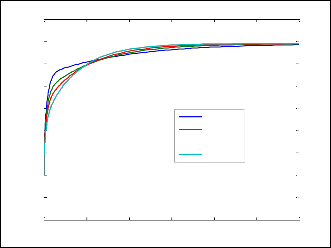

ISSN 2229-5518
65
60
55
50
45
V=1m/s
40 Tai=60°C V=2m/s
V=3m/s
35 V=5m/s
30
25
20
0 50 100 150 200 250 300
Drying time (min)
Fig. 4. Experimental characteristic-drying curves of grapes.
Fig. 7. Influence of the drying air velocity on the variation of air

temperature during drying.
1.2
70
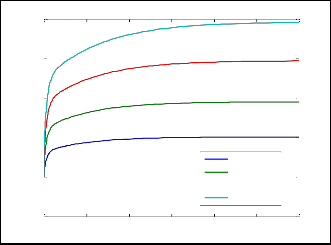
: Tai=45°C , V=2m/s
: Tai=50°C , V=1.5m/s
1 : Tai=55°C , V=1m/s 60
0.8
50
0.6
0.4
0.2
0
40
Tai=40°C Tai=50°C
V=2m/s Tai=60°C
Tai=70°C
20
0 0.2 0.4 0.6 0.8 1 1.2
Xr
0 50 100 150 200 250 300
Drying time (min)
Fig. 5. Simulated characteristic-drying curves of grapes.
Fig. 8. Influence of the drying air temperature on the variation of air
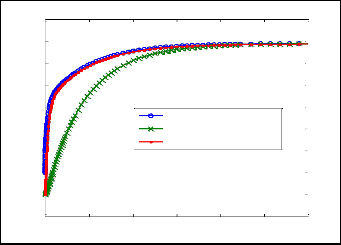
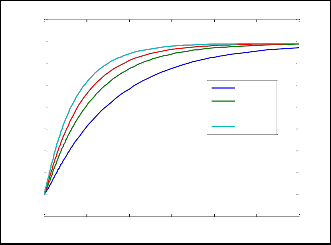
temperature during drying.
65
60
55
50
45
Air temperature
40 Product temperature
Inner wall temperature
35
30
25
20
65
60
55
50 V=1m/s
V=2m/s
45 Tai=60°C V=3m/s
40 V=5m/s
35
30
25
20
0 50 100 150 200 250 300
Drying time (min)
0 50 100 150 200 250 300
Drying time (min)
Fig. 6. Variation of air temperature, product temperature and inner wall temperature for Tai=60°C and V=3m/s.
Fig. 9. Influence of the drying air velocity on the variation of product temperature during drying.
IJSER © 2012
International Journal of Scientific & Engineering Research The research paper published by IJSER journal is about System Design, Mathematical Modelling and Simulation of Process Drying in a Solar-Gas Convective Tunnel Dryer 7
ISSN 2229-5518
70
60
50
40
Tai=50°C
30 V=2m/s Tai=60°C
Tai=70°C
20
0 50 100 150 200 250 300
Drying time (min)
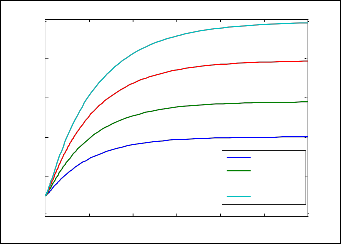
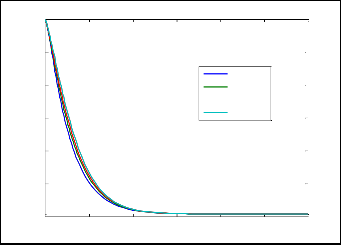
Fig. 10. Influence of drying air temperature on the variation of product temperature during drying.
6
5
V=1m/s
4 V=2m/s
Tai=60°C V=3m/s
3 V=5m/s
2
1
0
0 50 100 150 200 250 300
Drying time (min)
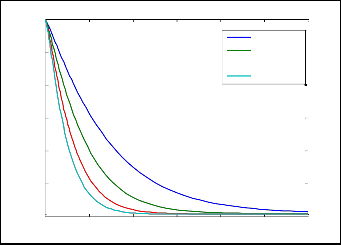
Fig. 11. Influence of drying air velocity on the variation of moisture content during drying.
6
Tai=40°C
5 Tai=50°C V=2m/s Tai=60°C
Tai=70°C
4
3
2
1
0
0 50 100 150 200 250 300
Drying time (min)
We are interested in the effects of two aero thermal factors, velocity and air temperature. These two parameters are varied for different tests to see their effects. We simulated using the model developed for convective drying process of thin product layer with a slab thickness of 0.8 cm.
This problem was studied previously [13]. Fig. 4 shows the characteristic drying curve established from a set of tests and experiments conducted in the laboratory. The shape of the Fig
4 is identical to that of Fig. 5. The methodology adopted in this study seems promising to give us more results.
rate as a function of the reduced moisture content at different air velocity and temperature values. It can be seen that the drying rate is not constant throughout the drying period. It constantly decreases drops until the equivalent moisture content of the product is reached.
Fig. 6 shows the evolution of air, product and inner wall
temperature inside the dryer for constant velocity and
temperature of the input hot air. The temperature of the
product does not reach very quickly the temperature of the
drying air compared to the air temperature and the inner wall.
This characterizes the following slow change in the temperature of a wet product in the drying process.
Fig. 7 and Fig. 8 show that the air temperature reaches very quickly the temperature of the drying air for different variation of temperature and velocity.
Fig. 9 and Fig. 10 show the influence of both of air and temperature of the drying air on the variation of the product temperature. Also the drying time is longer at slowly drying air velocity (V=1m/s).
Fig. 11 shows that the air velocity is not an influential parameter in the variation of the moisture content, as was the case in previous works [15-16].
Fig. 12 shows that the air temperature is an influential parameter in the variation of the moisture content, it was also demonstrated in other research publications [17-18]. Increasing the air temperature gives the air more evaporative power which is reflected in the drying time by making it shorter. We can notice that when the air velocity and the inlet temperature increase, the evaporation front moves faster and consequently the necessary time for drying decreases.
In this work, a mathematical model for convective drying process is presented which took into account the geometric design of the dryer and the thermal-physical properties of air and agricultural product. This modeling allowed us to describe the heat and mass transfer phenomena involved in food drying. The study shows that air temperature is an influential external parameter which is not the case of the air velocity. This is notable for the evolution of the temperature profiles and moisture content, also to appreciate the capacity of the developed model to describe the different drying periods.
Fig. 12. Influence of drying air temperature on the variation of moisture content during drying.
IJSER © 2012
International Journal of Scientific & Engineering Research The research paper published by IJSER journal is about System Design, Mathematical Modelling and Simulation of Process Drying in a Solar-Gas Convective Tunnel Dryer 8
ISSN 2229-5518
A surface area (m2)
aw water activity
Cp specific heat (J/kg°C)
Dh characteristic diameter of the layer of the product (m)
d mean thickness of the insulation (m)
g gravitational acceleration (m2/s)
hc convection heat-transfer coefficient (W/m2 °C) hd conduction heat-transfer coefficient (W/m2 °C) hm mass transfer coefficient(ms-1)
L characteristic length (m)
Lv latent heat of vaporization (J/kg)
l height of solar chimney(m)
m mass (kg)
![]()
m mass flow (kg/s)
Pi partial vapour pressure of the moist air (Pa)
v
Pvs saturated water vapour pressure (Pa)
T temperature (°C)
u velocity (m/s)
V volume (m3)
X product moisture content (kg/ kg dry basis)
Y air moisture content (kg/ kg dry basis)
Le Lewis number
Nu Nusselt number
Pr Prandtl number
Re Reynolds number
kinematic viscosity of air (m2/s)
density (kg/m3)
thermal conductivity (W/m°C)
a air
am ambient
pr product
wa wall
o output
i input/insulation l liquid
r reduced
v vapo in initial
e equilibrium
This study was supported by the Research Program of Ministry of High Education and Scientific Research in the setting of Tunisian Drying Process PRF11-ANME-ER01- Project .
[1] R. B. Keey "Drying principles and Practice". Oxford, UK.
[2] J.V. Brakel "Mass transfer in convective drying: In Advances in Drying". Vol. 1, A.S. Mujumdar Edn. Hemisphere Publication Corp., New York (1972).
[3] D. S. Lee and Y. R. Pyun, "Optimization of operating conditions in tunnel drying". Drying Technology, 11(5): pp.1025-1052(1993).
[4] S. B. Mabrouk, and A. Belghith 2000. "Development of the solar crop dryers in Tunisia". World Renewable Energy Congress VI, 3: pp.2206 – 2212(WREC”2000).
[5] N. Boukadida and S. B. Nasrallah "Mass and heat transfer during
water evaporation in laminar flow inside a rectangular channel— validity of heat and mass transfer analogy" Int. J. Therm. Sci. 40: pp. 67–81(2001).
[6] Y. Jannot and Y. Coulibaly "The evaporative capacity as a performance index for a solar-dryer air-heater". Solar energy Vol.63, No, 6: pp. 387-391(1991).
[7] J. M. Herrero and M.R. Heras-Celemin "Dynamic physical model for a solar chimney" Solar Energy 81: pp. 614–622 (2007).
[8] D. Pallet , M. Fournier and A. Themelin "Modélisation, Identification et simulation d’un Séchoir Solaire à Bois". Revue. Phys. Appl, 22: pp. 1399-1409(1987).
[9] W. K. Lewis, "The Rate of Drying of Solid Materials". Journal of
Industrial Engineering Chemistry, 13(5): pp. 427–432(1921).
[10] A. Lopez, A. Iguaz, A. Esnoz and P. Vırseda, "Thin Layer Behaviour Of Vegetable Wastes From Wholesale Market". Drying Technology, 18(4&5): pp. 985–994(2000a).
[11] C. Van Der Berg "Description of water activity of foods for
engineering purposes by means of the G.A.B. model of sorption". In B. M. McKenna (Ed.), Engineering and foods: Vol. 1 p. 311). New York: Elsevier Applied Science (1984).
[12] A. Lopez, A. Iguaz, A. Esnoz and P. Vırseda, "Modelling Of Sorption Isotherms Of Dried Vegetable Wastes From Wholesale Market". Drying Technology, 18(4&5) pp. 995–1006(2000b).
[13] S. B. Mabrouk , B. Khiari and M. Sassi "Modelling of heat and mass transfer in a tunnel dryer"Applied Thermal Engineering (26): pp. 2110–2118(2006).
[14] C. Tiris, N. Ozbalta, M. Tiris and I. Dincer Performance of a solar dryer. Energy, (19): pp. 993-997 (1994).
[15] L. Bennamoun and A. Belhamri "Numerical simulation of drying under variable external conditions: Application to solar drying of seedless grapes". Journal of Food Engineering, 76(2): pp.179–
187(2006).
[16] I. T.Tog˘rul and D. Pehlivan "Modelling of thin layer drying kinetics of some fruits under open-air sun drying process". Journal of Food Engineering, (65): pp. 413–425(2004).
[17] J. C. Laguerre, A. Lebert, G. Trystram and J. J. Bimbenet "A comparmental model to describe drying curves of foodstuffs under variable conditions". In A. S. Mujumdar & I. Filkova´ (Eds.), Drying 91 (pp. 361–368). Amsterdam, New York: Elsevier(1991).
[18] S. Azzouz, A. Guizani, W. Jomaa and A. Belghith "Moisture diffusivity and drying kinetic equation of convective drying of grapes". Journal of Food Engineering, (55): pp. 323–330 (2002).
IJSER © 2012